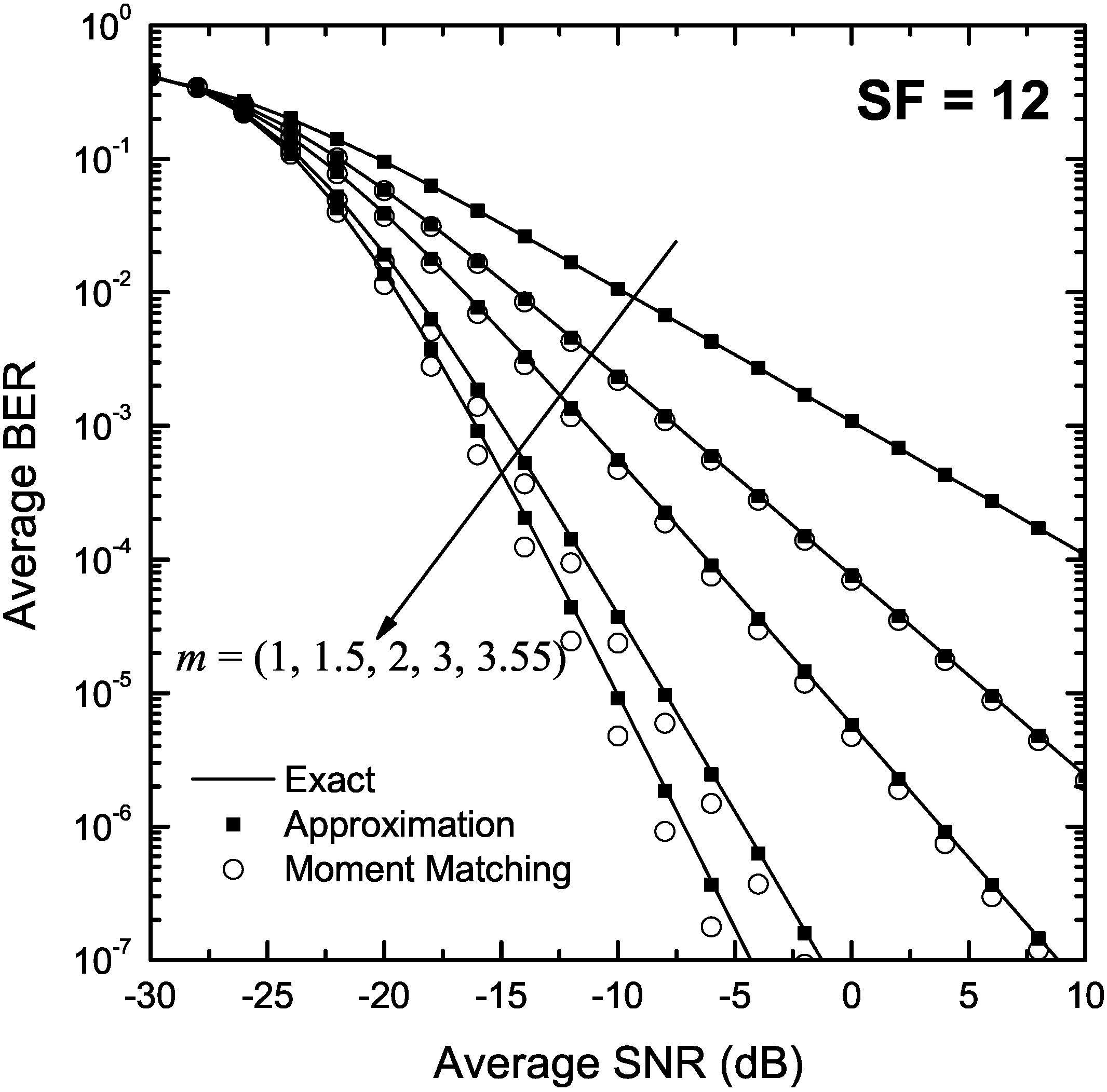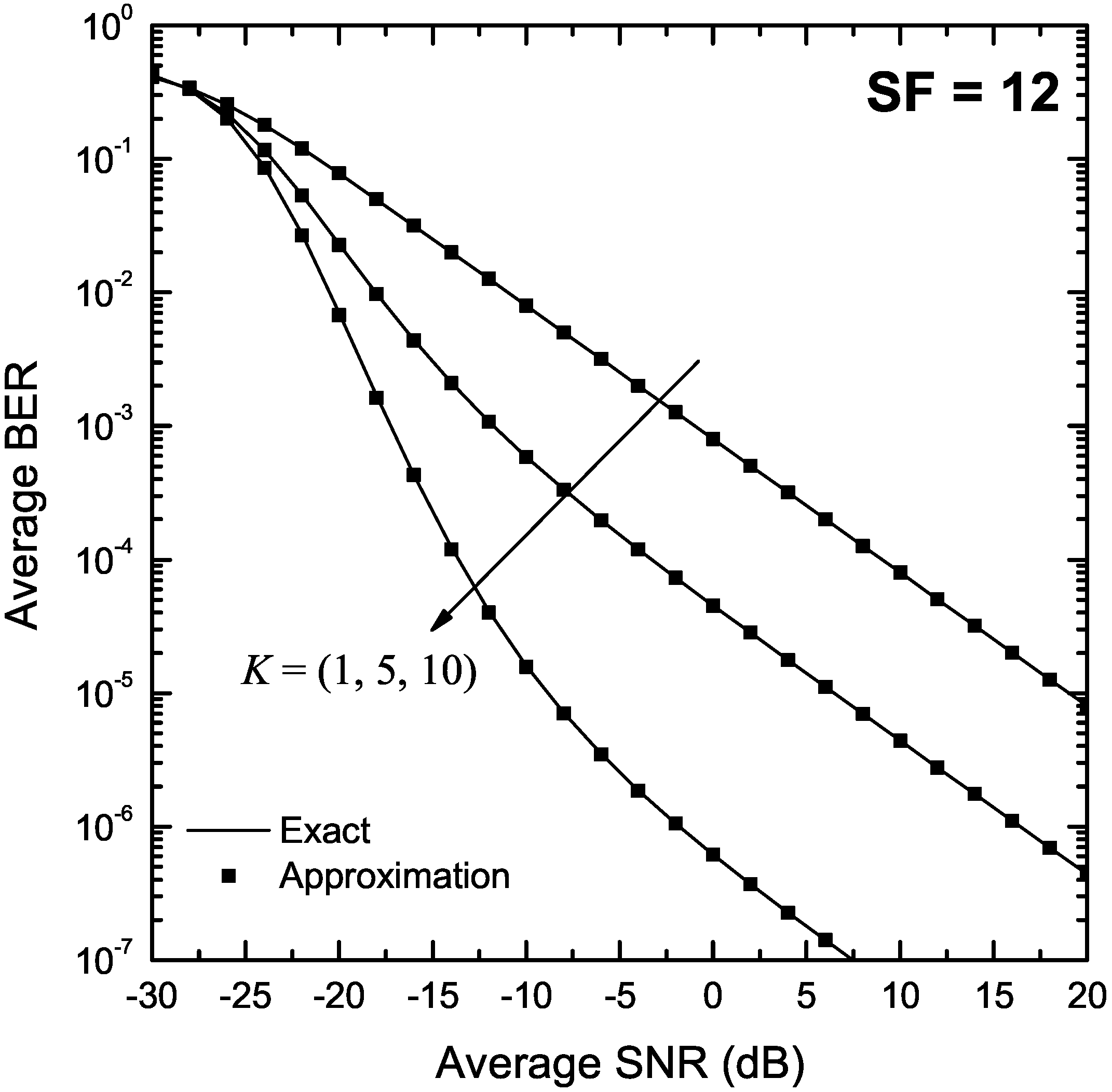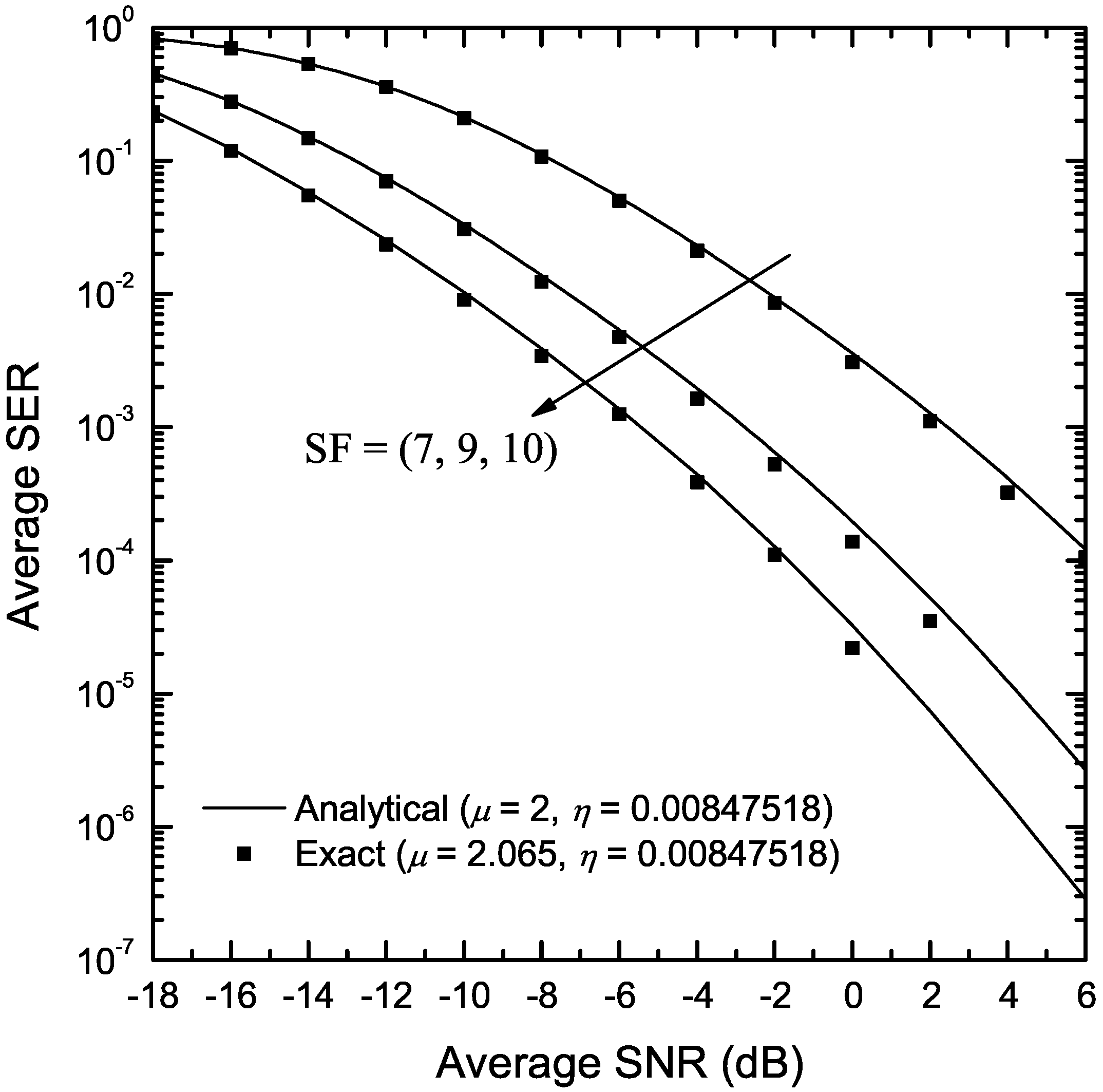New Results for the Error Rate Performance of LoRa Systems over Fading Channels
Abstract
:1. Introduction
- Under the assumption of Nakagami-m and Rice fading channels, we present approximate analytical expressions for the SER performance of LoRa systems. These expressions yield accurate results in the entire signal to noise ratio (SNR) region that are practically indistinguishable from the exact solution;
- For the special case of Nakagami-m fading, using a moment matching method, a simple yet tight approximation to the SER is obtained in closed form;
- For all fading scenarios, exact analytical SER expressions in terms of a single integral are presented;
- A novel, accurate analytical expression for the SER of LoRa systems operating in the presence of Hoyt fading is presented. To this end, a new integral involving exponentials, modified Bessel functions and the Marcum-Q function, whose second argument is a linear function of the integration variable, is evaluated;
- An exact single integral expression for the SER of LoRa systems operating over - fading channel is presented, assuming a propagation environment consisting of a finite number of multi-path clusters;
- An exact single integral expression for the SER of LoRa systems operating over generalized fading channels is presented, by approximating the PDF of the SNR with a mixture gamma distribution. As a test case, SER results of LoRa systems operating in the presence of - fading channels are presented.
2. Overview of the LoRa Modulation
- The input signal is sampled at a period of ;
- The resulting signal is then multiplied with a down chirp signal;
- A Fast Fourier Transform (FFT) is performed at the output of the previous block to retrieve the symbol value;
- The information signal is estimated using maximum likelihood detection.
3. Main Results
3.1. Symbol Error Probability for Nakagami-m Fading Channels
3.2. Symbol Error Probability for Rice Fading Channels
3.3. Symbol Error Probability for Hoyt Channels
3.4. Symbol Error Probability for Physical - Fading Channels
3.5. Symbol Error Probability for Generalized Fading Channels Using a Mixture Gamma Distribution
4. Numerical Results
| Algorithm 1 Monte-Carlo simulation methodology. |
Require: Number of samples
|
5. Conclusions
Author Contributions
Funding
Data Availability Statement
Conflicts of Interest
Appendix A. Evaluation of
| imaginary unit | |
| conjugate of the complex number z | |
| probability operator | |
| expectation of the random variable (RV) | |
| probability density function of the RV X | |
| cumulative distribution function of the RV X | |
| Kronecker delta function: for and 0 otherwise | |
| modified Bessel function of the first kind and order a [30] (Equation (8.431)) | |
| Gamma function [30] (Equation (8.310/1)) | |
| incomplete Gamma function [30] (Equation (8.350/2)) | |
| generalized hypergeometric function [30] (Equation (9.14/1)) | |
| generalized Marcum-Q function [35]: , | |
| The generalized Laguerre function of order [30] (Equation (8.972/1)): |
References
- Centenaro, M.; Vangelista, L.; Zanella, A.; Zorzi, M. Long-range communications in unlicensed bands: The rising stars in the IoT and smart city scenarios. IEEE Wirel. Commun. 2016, 23, 60–67. [Google Scholar] [CrossRef] [Green Version]
- Yang, G.; Liang, H. A Smart Wireless Paging Sensor Network for Elderly Care Application Using LoRaWAN. IEEE Sens. J. 2018, 18, 9441–9448. [Google Scholar] [CrossRef]
- Marais, J.M.; Malekian, R.; Abu-Mahfouz, A.M. Evaluating the LoRaWAN Protocol Using a Permanent Outdoor Testbed. IEEE Sens. J. 2019, 19, 4726–4733. [Google Scholar] [CrossRef]
- Raza, U.; Kulkarni, P.; Sooriyabandara, M. Low power wide area networks: An overview. IEEE Commun. Surv. Tut. 2017, 19, 855–873. [Google Scholar] [CrossRef] [Green Version]
- Loukatos, D.; Arvanitis, K.G. Multi-Modal Sensor Nodes in Experimental Scalable Agricultural IoT Application Scenarios. In IoT-Based Intelligent Modelling for Environmental and Ecological Engineering: IoT Next Generation EcoAgro Systems; Springer International Publishing: Cham, Switzerland, 2021; pp. 101–128. [Google Scholar] [CrossRef]
- Seller, O.; Sornin, N. Low Power Long Range Transmitter. U.S. Patent 14,170,170, 7 August 2014. [Google Scholar]
- Vangelista, L. Frequency shift chirp modulation: The LoRa modulation. IEEE Signal Process. Lett. 2017, 24, 1818–1821. [Google Scholar] [CrossRef]
- Chiani, M.; Elzanaty, A. On the LoRa modulation for IoT: Waveform properties and spectral analysis. IEEE Internet Things J. 2019, 6, 8463–8470. [Google Scholar] [CrossRef] [Green Version]
- Elshabrawy, T.; Robert, J. Interleaved chirp spreading LoRa-based modulation. IEEE Internet Things J. 2019, 6, 3855–3863. [Google Scholar] [CrossRef]
- Elshabrawy, T.; Robert, J. Capacity planning of LoRa networks with joint noise-limited and interference-limited coverage considerations. IEEE Sens. J. 2019, 19, 4340–4348. [Google Scholar] [CrossRef]
- Hoeller, A.; Souza, R.D.; López, O.L.A.; Alves, H.; de Noronha Neto, M.; Brante, G. Analysis and Performance Optimization of LoRa Networks With Time and Antenna Diversity. IEEE Access 2018, 6, 32820–32829. [Google Scholar] [CrossRef]
- Sanchez-Iborra, R.; Sanchez-Gomez, J.; Ballesta-Viñas, J.; Cano, M.D.; Skarmeta, A.F. Performance Evaluation of LoRa Considering Scenario Conditions. Sensors 2018, 18, 772. [Google Scholar] [CrossRef] [Green Version]
- Farhad, A.; Kim, D.H.; Pyun, J.Y. Resource Allocation to Massive Internet of Things in LoRaWANs. Sensors 2020, 20, 2645. [Google Scholar] [CrossRef] [PubMed]
- Matni, N.; Moraes, J.; Oliveira, H.; Rosario, D.; Cerqueira, E. LoRaWAN Gateway Placement Model for Dynamic Internet of Things Scenarios. Sensors 2020, 20, 4336. [Google Scholar] [CrossRef] [PubMed]
- Escobar, J.J.L.; Gil-Castineira, F.; Redondo, R.P.D. JMAC Protocol: A Cross-Layer Multi-Hop Protocol for LoRa. Sensors 2020, 20, 6893. [Google Scholar] [CrossRef]
- Bravo-Arrabal, J.; Fernandez-Lozano, J.J.; Seron, J.; Gomez-Ruiz, J.A.; García-Cerezo, A. Development and Implementation of a Hybrid Wireless Sensor Network of Low Power and Long Range for Urban Environments. Sensors 2021, 21, 567. [Google Scholar] [CrossRef] [PubMed]
- Novak, V.; Stoces, M.; Cízkova, T.; Jarolimek, J.; Kanska, E. Experimental Evaluation of the Availability of LoRaWAN Frequency Channels in the Czech Republic. Sensors 2021, 21, 940. [Google Scholar] [CrossRef] [PubMed]
- Zhao, Y.; Cao, C.; Liu, Z.; Mu, E. Intelligent Control Method of Hoisting Prefabricated Components Based on Internet-of-Things. Sensors 2021, 21, 980. [Google Scholar] [CrossRef] [PubMed]
- Chinchilla-Romero, N.; Navarro-Ortiz, J.; Muñoz, P.; Ameigeiras, P. Collision Avoidance Resource Allocation for LoRaWAN. Sensors 2021, 21, 1218. [Google Scholar] [CrossRef]
- Lee, J.; Yoon, Y.S.; Oh, H.W.; Park, K.R. DG-LoRa: Deterministic Group Acknowledgment Transmissions in LoRa Networks for Industrial IoT Applications. Sensors 2021, 21, 1444. [Google Scholar] [CrossRef]
- Elshabrawy, T.; Robert, J. Closed-form approximation of LoRa modulation BER performance. IEEE Commun. Lett. 2018, 22, 1778–1781. [Google Scholar] [CrossRef]
- Dias, C.F.; Lima, E.R.D.; Fraidenraich, G. Bit error rate closed-form expressions for LoRa systems under Nakagami and Rice fading channels. Sensors 2019, 19, 4412. [Google Scholar] [CrossRef] [Green Version]
- Courjault, J.; Vrigenau, B.; Berder, O.; Bhatnagar, M. A Computable Form for LoRa Performance Estimation: Application to Ricean and Nakagami Fading. IEEE Access 2021, 9, 81601–81611. [Google Scholar] [CrossRef]
- Ma, H.; Cai, G.; Fang, Y.; Chen, P.; Han, G. Design and Performance Analysis of a New STBC-MIMO LoRa System. IEEE Trans. Commun. 2021, 69, 5744–5757. [Google Scholar] [CrossRef]
- Xu, W.; Cai, G.; Chen, G. Performance analysis of a two-hop relaying LoRa system. In Proceedings of the IEEE/CIC International Conference on Communications in China (ICCC), Xiamen, China, 28–30 July 2021. [Google Scholar] [CrossRef]
- Wolfram Research, Inc. Mathematica; Version 13.0.0; Wolfram Research, Inc.: Champaign, IL, USA, 2021. [Google Scholar]
- Yacoub, M.D. The κ-μ and the η-μ distribution. IEEE Antennas Propag. Mag. 2007, 49, 68–81. [Google Scholar] [CrossRef]
- Simon, M.K.; Alouini, M.S. Digital Communication Over Fading Channels, 2nd ed.; Wiley: New York, NY, USA, 2005. [Google Scholar]
- Prudnikov, A.P.; Brychkov, Y.A.; Marichev, O.I. Integrals and Series Volume 4: Direct Laplace Transforms, 1st ed.; CRC Press: Boca Raton, FL, USA, 1992. [Google Scholar]
- Gradshteyn, L.; Ryzhik, I.M. Table of Integrals, Series, and Products, 6th ed.; Academic Press: San Diago, CA, USA, 2000. [Google Scholar]
- Cui, G.; Kong, L.; Yang, X.; Ran, D. Two useful integrals involving generalised Marcum Q-function. Electron. Lett. 2012, 48, 1017–1018. [Google Scholar] [CrossRef]
- Abdi, A.; Lau, W.C.; Alouini, M.S.; Kaveh, M. A New Simple Model for Land Mobile Satellite Channels: First- and Second-Order Statistics. IEEE Trans. Wirel. Commun. 2003, 2, 519–528. [Google Scholar] [CrossRef] [Green Version]
- Prudnikov, A.P.; Brychkov, Y.A.; Marichev, O.I. Integrals and Series Volume 3: More Special Functions, 1st ed.; Gordon and Breach Science Publishers: Langhorne, PA, USA, 1986. [Google Scholar]
- Munkhammar, J.; Mattsson, L.; Rydén, J. Polynomial probability distribution estimation using the method of moments. PLoS ONE 2017, 12, e0174573. [Google Scholar] [CrossRef] [Green Version]
- Nuttall, A.H. Some Integrals Involving the QM function. IEEE Trans. Inf. Theory 1975, 21, 95–96. [Google Scholar] [CrossRef]
- Ermolova, N.Y.; Tirkkonen, O. Laplace Transform of Product of Generalized Marcum Q, Bessel I, and Power Functions With Applications. IEEE Trans. Signal Process. 2014, 62, 2938–2944. [Google Scholar]
- Morales-Jimenez, D.; Paris, J.F. Outage Probability Analysis for η-μ Fading Channels. IEEE Commun. Lett. 2010, 14, 521–523. [Google Scholar] [CrossRef]
- Ermolova, N.Y.; Tirkkonen, O. The η-μ fading distribution with integer values of μ. IEEE Trans. Wireless Commun. 2011, 10, 1976–1982. [Google Scholar] [CrossRef]
- Peppas, K.P.; Alexandropoulos, G.; Mathiopoulos, P.T. Performance Analysis of Dual-Hop AF Relaying Systems over Mixed η-μ and κ-μ Fading Channels. IEEE Trans. Veh. Technol. 2013, 62, 3149–3163. [Google Scholar] [CrossRef]
- Atapattu, S.; Tellambura, C.; Jiang, H. A Mixture Gamma Distribution to Model the SNR of Wireless Channels. IEEE Trans. Wirel. Commun. 2011, 60, 4193–4203. [Google Scholar] [CrossRef]
- Loukatos, D.; Fragkos, A.; Arvanitis, K. Experimental Performance Evaluation Techniques of LoRa Radio Modules and Exploitation for Agricultural Use. In Information and Communication Technologies for Agriculture—Theme I: Sensors; Bochtis, D.D., Lampridi, M., Petropoulos, G.P., Ampatzidis, Y., Pardalos, P., Eds.; Springer International Publishing: Cham, Switzerland, 2022; pp. 101–120. [Google Scholar] [CrossRef]
- Zhu, S.; Ghazaany, T.S.; Jones, S.M.R.; Abd-Alhameed, R.A.; Noras, J.M.; Buren, T.V.; Wilson, J.; Suggett, T.; Marker, S. Probability Distribution of Rician-Factor in Urban, Suburban and Rural Areas Using Real-World Captured Data. IEEE Trans. Antennas Propag. 2014, 62, 3835–3839. [Google Scholar] [CrossRef]










| Authors | Title | Source | Findings |
|---|---|---|---|
| Vangelista, L. | Frequency shift chirp modulation: The LoRa modulation | [7] | Introduced the LoRa modulation system and provided initial results on its performance over AWGN channels by means of a single integral. |
| Elshabrawy, T.; Robert, J. | Closed-form approximation of LoRa modulation BER performance | [21] | Provided simple closed-form expressions of LoRa systems in the presence of AWGN and Rayleigh fading. |
| Dias, C.F.; Lima, E.R.D.; Fraidenraich, G. | Bit error rate closed-form expressions for LoRa systems under Nakagami and Rice fading channels. | [22] | Provided an exact closed-form expression for the BER of LoRa systems under Rayleigh fading as well as analytical expressions for the BER under Nakagami-m and Rice fading in terms of a finite sum. |
| Courjault, J.; Vrigenau, B.; Berder, O.; Bhatnagar, M. | A Computable Form for LoRa Performance Estimation: Application to Ricean and Nakagami Fading. | [23] | Authors elaborate on the properties of the generalized Marcum Q-function to provide accurate expressions for the BER of LoRa systems in the presence of Rice and Nakagami-m fading. |
| Hoeller, A.; et al. | Analysis and Performance Optimization of LoRa Networks With Time and Antenna Diversity | [11] | Authors addressed the performance of LoRa systems operating in the presence of Rayleigh fading, enhanced with antenna and time diversity techniques. The optimization of the performance of such systems has further been addressed. |
| Ma, H.; Cai, G.; Fang, Y.; Chen, P.; Han, G. | Design and Performance Analysis of a New STBC-MIMO LoRa System | [24] | Authors have proposed a new STBC MIMO LoRa system architecture. Its theoretical performance was analyzed in the presence of Rayleigh fading. A closed-form approximate BER expression of the proposed system under perfect and imperfect channel state information (CSI) was proposed. |
| Xu, W.; Cai, G.; Chen, | Performance analysis of a two-hop relaying LoRa system | [25] | Authors studied a two-hop opportunistic amplify-and-forward relaying LoRa system employing a best relay-selection protocol and operating over Nakagami-m fading. |
Publisher’s Note: MDPI stays neutral with regard to jurisdictional claims in published maps and institutional affiliations. |
© 2022 by the authors. Licensee MDPI, Basel, Switzerland. This article is an open access article distributed under the terms and conditions of the Creative Commons Attribution (CC BY) license (https://creativecommons.org/licenses/by/4.0/).
Share and Cite
Peppas, K.; Chronopoulos, S.K.; Loukatos, D.; Arvanitis, K. New Results for the Error Rate Performance of LoRa Systems over Fading Channels. Sensors 2022, 22, 3350. https://doi.org/10.3390/s22093350
Peppas K, Chronopoulos SK, Loukatos D, Arvanitis K. New Results for the Error Rate Performance of LoRa Systems over Fading Channels. Sensors. 2022; 22(9):3350. https://doi.org/10.3390/s22093350
Chicago/Turabian StylePeppas, Kostas, Spyridon K. Chronopoulos, Dimitrios Loukatos, and Konstantinos Arvanitis. 2022. "New Results for the Error Rate Performance of LoRa Systems over Fading Channels" Sensors 22, no. 9: 3350. https://doi.org/10.3390/s22093350
APA StylePeppas, K., Chronopoulos, S. K., Loukatos, D., & Arvanitis, K. (2022). New Results for the Error Rate Performance of LoRa Systems over Fading Channels. Sensors, 22(9), 3350. https://doi.org/10.3390/s22093350









